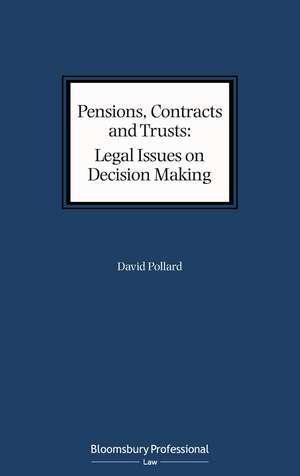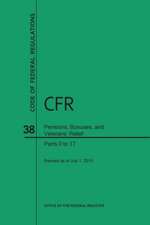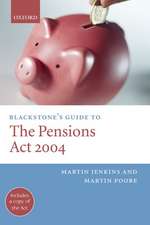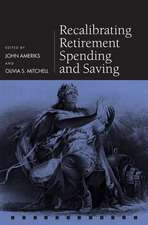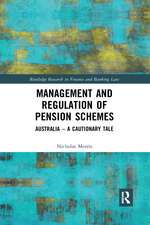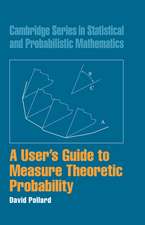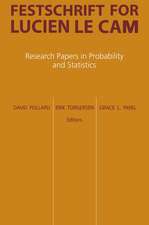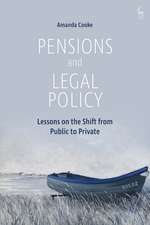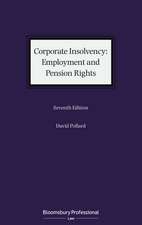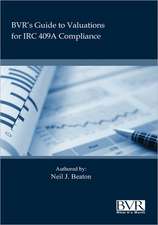Pensions, Contracts and Trusts: Legal Issues on Decision Making
Autor David Pollarden Limba Engleză Hardback – 17 mai 2020
Preț: 899.39 lei
Preț vechi: 1110.91 lei
-19% Nou
Puncte Express: 1349
Preț estimativ în valută:
172.14€ • 177.40$ • 145.33£
172.14€ • 177.40$ • 145.33£
Carte disponibilă
Livrare economică 10-24 februarie
Preluare comenzi: 021 569.72.76
Specificații
ISBN-13: 9781526511836
ISBN-10: 1526511835
Pagini: 640
Dimensiuni: 156 x 248 mm
Greutate: 1.23 kg
Editura: Bloomsbury Publishing
Colecția Bloomsbury Professional
Locul publicării:London, United Kingdom
ISBN-10: 1526511835
Pagini: 640
Dimensiuni: 156 x 248 mm
Greutate: 1.23 kg
Editura: Bloomsbury Publishing
Colecția Bloomsbury Professional
Locul publicării:London, United Kingdom
Caracteristici
Topical area for the courts, which have moved to imply various limitations or tests on decision makers powers and when they can be challenged
Notă biografică
David is a leading and highly experienced lawyer in the pensions field and related areas. He switched to practice as a barrister at the end of 2017, after 37 years practice as a solicitor, including 25 years as a partner in law firm Freshfields Bruckhaus Deringer. David's practice focuses on: Pensions law, Insolvency law, Employment law (involving pensions). David's practice as a solicitor included advising employers and trustees in relation to pension law matters, including corporate transactions, scheme funding, scheme mergers, scheme changes, employer insolvency and Pensions Regulator issues.
Cuprins
Part 1: Introduction 1. Introduction Part 2: Legal review of decisions: General 2. Legal review of decisions: Major Tests 3. Expanded outline of major tests 4. Exceptions and qualifications 5. Public Law analogy in private law discretions? 6. Construction - General 7. Interpretation of Pension Schemes Part 3: Types of decision and who is the decision maker 8. Nature of discretion 9. Who is the decision maker? Part 4: Proper Purposes - Applying Eclairs 10. Proper purposes: Introduction 11. Eclairs 12. The proper purpose test 13. Purpose test in Trust Law and Company Law 14. How is the proper purpose test applied? 15. Can proper purposes apply where there has been a failure to act? 16. How is the decision maker's purpose worked out? 17. Causation/More than one motive or intention 18. More than one decision maker 19. Purpose verses motive? 20. Effect of improper exercise 21. Proper Purposes: Conclusion Part 5: Proper Purposes - Application to Pension Schemes 22. Proper Purposes and pension schemes: Introduction 23. Pension scheme and Trustee powers 24. Overall Purpose of a pension scheme 25. Pensions: Main purpose verses Sole purpose? 26. Pension trusts: Examples of the application of the proper purpose test 27. Pension schemes: Amendment powers/Change of Principal28. Transfers-in 29. Transfers out: Fletcher Challenge and ITS v Hope 30. Investment 31. Early retirement reduction 32. Commutation factors 33. Pension increases 34. Winding-up a pension scheme? 35. Pension Regulator powers 36. Trustees exercising powers fairly 37. Pension Trustees and Proper Purposes: Overview 38. No literal 'best interests' duty for trustees Part 6: Braganza 1: Due consideration of relevant factors 39. Braganza - a landmark case 40. Braganza: the Decision 41. The Braganza rationality Test 42. Trustees and Braganza: Beyond a Good faith test 43. Trustees and public law analogies following Braganza 44. Does Braganza apply to all commercial discretions? 45. Intensity of review 46. Braganza first limb - process: relevant factors 47. Trustees and relevant factors: Pitt v Holt compared with Braganza 48. Three types of relevant factors: the public law approach 49. Limits on enquiries: properly informed, but not an 'endless search' 50. Weight given to factors Part 7: Braganza 2: No reasonable decision maker: Perversity 51. Braganza 52. Arbitrary, capricious etc 53. Timing for irrationality? 54. What if one reasonable decision maker would have made the same decision? 55. Braganza 2 test is a limit on a power? Part 8: Braganza rationality tests: interaction with the proper purpose test 56. Braganza and proper purposes tests 57. Braganza and MDTC/Contractual/Imperial duty Part 9: Further common issues on the proper purposes and Braganza tests 58. Multiple decision makers 59. Decision maker would have made the same decision anyway? 60. Decision maker giving reasons Part 10: Remedies for a Failure? 61. Remedies 62. Fiduciary Duties 63. Reversal or cancellation of the decision: void or voidable 64. Damages or equitable compensation for breach of trust/duty 65. Impact on third parties 66. Removal of the decision maker 67. Exclusion clauses 68. Overturning a decision - reference back to decision maker Part 11: Trustees and Directors: Fetters on Discretion 69. Discretions and fetters 70. Statements of a no fetter rule 71. Fetters: Some older cases 72. The Fetters rule gets more sensible: three modern cases: Thorby; Cabra Estates and Firkin-Flood 73. Fetters: Modern position 74. Pension schemes and fetters 75. Fetters: is public law any guide? 76. Fetters: Directors and Companies 77. Fetters and changes of trustees 78. Fetters: Outside parties 79. Fetters: Impact on Third parties 80. Fetters and a Power of amendment 81. Setting policies or guidelines?
Recenzii
If any textbook can be thoroughly recommended to Trust Quarterly Review (TQR) readers, this is it. It is a truly international survey of the - quite radical - developments introduced into the circumstances where the courts will intrude into decision-making by, among others, trustees.
This book should be attractive to the entire range of legal professionals, including academics and practitioners, and not only those operating in the superannuation field. Pollard has accomplished the difficult feat of presenting the material in a way that is accessible to practitioners while ensuring that the content is comprehensive, thoroughly researched and argued in a way that should make it an indispensable resource for those involved in their own research and teaching in the area. . I have already had occasion to resort to my review copy in providing advice to clients and am certain I will be using it in future research projects.
This book should be attractive to the entire range of legal professionals, including academics and practitioners, and not only those operating in the superannuation field. Pollard has accomplished the difficult feat of presenting the material in a way that is accessible to practitioners while ensuring that the content is comprehensive, thoroughly researched and argued in a way that should make it an indispensable resource for those involved in their own research and teaching in the area. . I have already had occasion to resort to my review copy in providing advice to clients and am certain I will be using it in future research projects.
